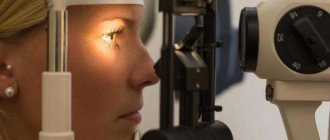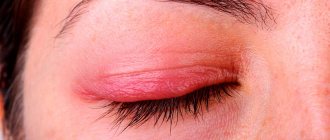Causes
Flashes of light in the eyes, vision problems and discomfort arise due to the progression of pathologies in the body such as:
- Vitreous detachment. With such a violation, light effects are a consequence of deformation and stretching of the gel-like substance, which, under the influence of pathological factors, gradually peels off from its place. Flashes and a feeling as if dots are flying in front of the eyes occur when turning the head in different directions.
- Retinal separation and rupture. This is a dangerous disease that often leads to complete loss of vision. Detachment can occur due to a sharp jump in blood pressure, trauma, or severe stress. The patient notes that there is sparkling and sparkling in the right or left eye; if you look with peripheral vision, a spot forms in the field, which can be dark or white.
- Migraine attack. In addition to prolonged and painful headaches, flashes appear in the eyes; the symptom is especially troubling when moving or when standing up suddenly.
- Cardiovascular diseases. Due to spasms and impaired cerebral circulation, a person is bothered by flickering when blinking and even with his eyes closed.
- Neoplasms in the brain. Due to the increase in size of the tumor, blue, purple, and red sparkles appear in the eyes. In addition, the patient experiences convulsions, localized headaches on the right or left side, impaired consciousness, and blurred vision.
- Injuries and damage to the eyeball. A common cause of these symptoms. Swelling and hematoma on the skin of the eyelids, a decrease in protein volume, and acute pain when pressing will help you understand that the eye is injured.
- Infectious and inflammatory diseases. These include conjunctivitis, blepharitis, and keratitis.
Features of the problem - symptoms and signs
Flashes and spots in the eyes are considered a serious phenomenon, but, unfortunately, many often do not pay attention to them. They can cause serious health problems, and if necessary measures are not taken in time, complete blindness can occur over time.
Flashes of bright light in the eyes are called “photopsia” by many doctors. Often this symptom occurs due to reasons related to visual impairment. It happens that bright spots, rods, and floaters in the eyes appear as a result of thinning or rupture of the retina. This condition is very dangerous, and if the required measures are not taken, retinal detachment may eventually occur.
Sometimes outbreaks can occur against the background of oncological processes that have arisen in the organs of vision.
But it is still worth remembering that outbreaks are not a disease, they are considered a consequence of a specific illness. If they appear, you should immediately consult a doctor, this will help to identify the cause in a timely manner.
"Bunnies" in the eyes. Eye burns
Due to ignorance and inattention, it turns out that it is very easy to get radiation burns to the eyes. Vera Grigorievna BONDAREVA , a doctor of the highest category, head of the emergency department of the Moscow Ophthalmological Clinical Hospital, says “We are most often approached with eye burns by people who, due to lack of funds, independently repair their cars or perform some welding work on the construction of their dachas. Not only are their own eyes often not at all protected from the blinding light, but they also ask their wives or relatives to hold something, and then the children stare with all their eyes at what the adults are doing so interestingly. Fortunately, such outbreaks cause relatively mild eye burns. A person returns home, and after a few hours, most often at night, pain in the eyes, pain, tearing, and photophobia appear. In principle, no treatment is required in this case, because within one day all these unpleasant phenomena go away on their own. But nevertheless, when people contact us, we recommend applying cold lotions with tea infusion or plain water to the eyes to relieve painful sensations, and instilling any liquid vitamins that are on hand, or sterilized vegetable oil, into the eyes. at least sunflower. And if possible, buy vitamin eye drops “Taufon” or “Citral” at the pharmacy. In recent years, the reason for another “type” of eye burns has been the abundance of beauty salons with solariums, in which our beauties and handsome men sunbathe in the winter months. I have no reason to advocate against fake tanning to anyone, but unfortunately, we sometimes have to deal with much sadder situations than what is shown in the “Take a break, eat a Twix” commercial. It seems that in some tanning salons they have no idea at what distance a person can be irradiated, or what the exposure time should be, and they don’t know at all about the need to use protective glasses for such a tan. Young people are brought to us with burns to both eyes and skin. Some of them have to be urgently taken to the Sklifosovsky Institute, where there is a burn center. In such cases, it is much more difficult to treat the eyes, and this requires not just days, but weeks. It is even more difficult to treat solar and snow ophthalmia, that is, eye burns that sometimes occur during winter holidays somewhere in the mountains, in the bright sun and especially after a snowfall, when everything around sparkles and sparkles with all the colors of the rainbow. Climbers and skiers have never approached us with such complaints, but there have been several cases when we treated tourists. They all claimed that they used safety glasses, but they could not protect their eyes. Apparently, they were wearing glasses with only tinted lenses, but they needed glasses that cut off radiation from a range dangerous to the eyes. If light burns that occur during welding affect the anterior segment of the eye - the mucous membrane and cornea, then snow and solar ophthalmia can seriously damage the retina. Subjectively, this is expressed in the appearance of translucent spots in front of the eyes that interfere with vision. We hospitalize such patients, because any pathology of the retina is fraught with a decrease in visual acuity, which can last a lifetime. If such burns are not treated, this can lead to complete loss of vision. Previously, we did not encounter solar ophthalmia so often - there were two or three cases a year. But after the solar eclipse on August 11 last year, more than twenty people were hospitalized. Despite all the warnings about the need to protect their eyes, these people without glasses watched as the sun's crescent appeared from behind the lunar disk. The result is sad. Be careful. © “Computer and Vision”
Other symptoms
A person should definitely visit a doctor if a symptom occurs along with a headache that cannot be relieved with medications. If a person’s eyes flashed only once, but after reducing the load and normalizing the daily routine, the signs disappeared, there is nothing to worry about. Regularly recurring flashes before the eyes mean that something is wrong with the body. It is important to consult an ophthalmologist as soon as possible if sparkling eyes are accompanied by the following symptoms:
- a white veil in the field of vision, preventing normal vision;
- frequent headaches that do not go away after taking painkillers;
- dizziness, nausea;
- disorientation in space;
- deterioration in general health;
- sudden jumps in blood pressure;
- photophobia;
- increased tearfulness or, conversely, dry mucous membranes;
- the formation of an extensive capillary network on proteins.
It is necessary to urgently call an ambulance if the child’s pupils are dilated and does not respond to external stimuli. This condition may be the result of severe intoxication, trauma, or concussion.
Flickering in the eyes and pain in the head area
Flickering before the eyes, accompanied by a headache, often occurs in the presence of the following pathologies:
- Heart diseases;
- Osteochondrosis;
- Various pathologies of the organs of vision.
The intensity of pain may change in the following cases:
- When exposed to sunlight;
- With a sharp tilt of the head.
When flickering in the eyes is accompanied by a headache, the following symptoms may also occur:
- Increased lacrimation;
- Nausea;
- The appearance of dizziness;
- Drowsiness.
The patient’s well-being can be improved with the help of drugs that have analgesic effects. Some of these medications are listed in the table below.
| Name of the medication | Features of the medicine |
| "Citramon" | The medicine contains caffeine. “Citramon” not only helps to get rid of pain, but also gives vigor. It is recommended to avoid using the medication during lactation and pregnancy. The medicine is contraindicated in the presence of severe kidney disease, hemophilia, and cirrhosis of the liver. Citramon helps increase blood pressure. The drug is not recommended for use in case of hypertension |
| "Pentalgin N" | The medication contains components such as analgin, codeine, caffeine, and phenobarbital. "Pentalgin N" helps relieve pain. The drug improves sleep and has a sedative effect |
| "Tempalgin" | The drug helps eliminate headaches of any etiology. The recommended daily dosage is 3-6 tablets |
| "Paracetamol" | The medicine, which helps get rid of headaches, has a pronounced antipyretic and anesthetic effect. |
| "Solpadeine" | The medicine contains: paracetamol, caffeine, codeine. "Solpadeine" helps eliminate headaches and relieves fatigue perfectly. The effect of taking the medication is noticeable after a short period of time (after about 5 minutes) |
| "Buskopan" | The drug is endowed with a pronounced antispasmodic effect. The medicine quickly relieves pain |
What do lightning in the eyes mean or reasons
Lightning and flashes can be a symptom of a large number of eye diseases. Most often this indicates a rupture or detachment of the retina .
Other diseases and injuries can also cause lightning:
- Chorioditis is an inflammatory process of the vessels that provide nutrition to the retina of the eye.
- Glaucoma is increased pressure in the eye.
- Cataract is clouding of the lens of the eye.
- Neuritis (inflammation) of the optic nerves.
- Various types of tumors that lead to retinal damage. May be a primary or secondary lesion.
- Macular edema as a consequence of injury to the eyeball.
- Hemorrhage in the eyeball.
- Asteroid bodies - the appearance of white crystal balls in the vitreous body.
- Impaired blood circulation in the organs of vision.
- The process of detachment of the posterior part of the vitreous.
- Ocular migraine or scintillating scotoma is a distortion of the image as a result of poor circulation within the eye.
- Damage to the optic nerve, up to atrophy.
- Eye injuries causing cataracts.
Diagnostic measures
The doctor will be able to make a more accurate diagnosis of the patient after performing optical tomography. Before the doctor prescribes therapy, he must find out exactly what the light flashes in the eyes mean and for what reasons they occur. During the physical examination, the doctor will check how the patient sees directly and from the side, and will ask you to make test movements with the pupils. To clarify the diagnosis, the patient is given a referral to undergo a number of diagnostic procedures such as:
- ophthalmoscopy;
- perimetry;
- tonometry;
- visometry;
- fundus examination;
- optical tomography;
- fluorescein angiography;
- Ultrasound of the visual system;
- computer or magnetic resonance imaging of the brain.
Useful video
In the presented video you can find more information on the topic of eye diseases and the causes of various visual effects.
Author's rating
Author of the article
Alexandrova O.M.
Articles written
2029
about the author
Was the article helpful?
Rate the material on a five-point scale!
( 3 ratings, average: 2.33 out of 5)
If you have any questions or want to share your opinion or experience, write a comment below.
What measures should be taken
It turned out that photopsia is not an independent, not a separate eye disease. Photopsia is a symptom of a specific diagnosis. To eliminate this phenomenon, you need to find out what pathology the organs of vision have suffered and treat it. Once positive results are achieved, the phenomenon of photopsia will disappear on its own.
Where to begin? First you need to visit an ophthalmologist. The specialist will examine your eyes by examining the fundus. It is impossible to do this yourself. The doctor examines the retina and vitreous body using a slit lamp with a special lens, as well as an ophthalmoscope. Then determine the disease that caused this phenomenon and prescribe a specific course of therapy.
Therapy will be aimed at normalizing the condition of the visual organs, as well as eliminating the pathological process.
Emergency methods and interventions are possible in case of retinal or vitreous detachment. If the process is started and irreversible, then microsurgeons resort to the method of vitrectomy and prosthetics. Fill the cavity with gas or silicone. If the lesions are not so serious, then it is enough to perform a laser coagulation procedure of the affected vessels. This procedure prevents the progression of the disease.
What treatment is prescribed?
Medication
Dietary supplements can be included in the therapeutic complex of drugs for infectious-inflammatory pathology of the visual organs. If sparks in the eyes are a consequence of the progression of an infectious-inflammatory disease, then drug therapy will be required. The following groups of drugs are used for treatment:
- antibiotics;
- antiseptics;
- non-steroidal anti-inflammatory drugs;
- glucocorticosteroids;
- antihistamines;
- decongestants;
- painkillers;
- vitamin and mineral complexes, dietary supplements.
Surgical
If flashes in the eyes are a consequence of vitreous detachment, retinal dissection or other intraocular disorders, surgical treatment is required to prevent the progression of degenerative processes. The most common eye surgeries are:
- vitrectomy;
- scleroplasty;
- laser coagulation.
In the presence of a tumor, brain surgery is the only sure way to solve the patient’s problem. The most severe and dangerous disease that causes flashes in the field of vision is an oncological tumor localized in the brain. In this case, a radical operation is prescribed, during which the tumor is removed. The procedure will be followed by rehabilitation, during which the patient will need to undergo a course of chemical, radiation and restorative therapy. If the tumor is diagnosed in the early stages and does not metastasize, the prognosis for successful recovery is favorable.
Folk remedies
Non-traditional methods of therapy can be used as auxiliary and preventive treatment. For frequently recurring infectious and inflammatory eye diseases, it is recommended to take a vitamin infusion for a course of 2 months, the preparation method of which is simple:
- Pour 3 tbsp into a thermos. l. fresh blueberries and pour 2 liters of boiling water over everything.
- Close the container tightly with a lid and leave to infuse for 3 hours.
- You need to drink the finished product a day, use the infusion as tea, you can add a little honey or sugar to taste.
If conjunctivitis is diagnosed, you can prepare an herbal decoction to wash the eyes. The recipe is:
Chamomile and calendula can be added to the medicinal decoction.
- Boil 300 ml of water, add 2 tbsp. l. a mixture of chamomile, calendula, sage and thyme flowers, taken in equal proportions.
- Cover the container with a lid, reduce heat and simmer for 5 minutes.
- Remove the broth from the stove and let it brew for another 1 hour.
- Strain the product and cool to room temperature.
- Using a pipette or syringe, rinse the eyes with a bactericidal decoction daily, 4-6 times a day, until the pathological symptoms disappear.
How to protect your eyes from snow blindness?
The 2021 article “On the Relevance of Eye Protection from Snow Blindness in Arctic Conditions,” from the collection of scientific articles of the 2nd International Scientific Conference of Advanced Developments of Young Scientists, explains that in the past, polar explorers used a wide variety of protective equipment to protect their eyes. Thus, in the 19th century, members of Ferdinand Wrangel’s covered their eyes with black crepe, Captain George DeLong’s used horsehair nets, and Robert Peary used pieces of fur. Red and blue silk veils, light filter glasses made from animal bones, and leather bandages with narrow slits were also used. Northern peoples, such as the Eskimos, Nenets, and Chukchi, used wooden or bone plates with slots to protect their eyes.
As reported in the article, at the present stage of technology development, the most reliable means of preventing diseases of the mucous membrane of the eye from exposure to reflected ultraviolet radiation are filter glasses. Such optical devices are used for eye protection in the Arctic and have yellow or smoky glass. Doctors and most Arctic researchers prefer filter glasses with smoky lenses. The rationale for this choice is that, while reducing the brightness of the lighting, they do not change the perception of surrounding objects.
Article on the topic
The look of a mutant. The most unusual and rare eye diseases
Other polar explorers, such as Roald Amundsen and Richard Byrd , considered yellow to be the best color for glass. This is due to the fact that yellow lenses improve contrast, which makes it easier for a person to orientate himself in the Arctic, where on a cloudy day the sky, ice and snow merge into a solid white spot.
There are also photochromic glasses, which change their color depending on the light: darken or lighten. However, in Arctic conditions, this feature becomes absolutely useless, since without the bright sun, the lenses of the glasses become lighter and cease to protect the eyes from snow blindness, and it is on cloudy days that the danger of eye damage from ultraviolet radiation increases significantly.
At the same time, ordinary sunglasses purchased at resorts protect only from bright sunlight, but easily transmit ultraviolet radiation.
Currently, a solution to the problem of protecting the organs of vision from snow blindness, namely the choice of the type of lenses for filter glasses, is still being developed.
Treatment
As noted earlier, flashes and lightning in the eyes in 80% of cases are the result of various ailments. Therefore, possible treatment for photopsia is selected taking into account the diagnosis made by doctors.
If the patient has significant damage to the retinal tissue or hemorrhages occur, then surgical intervention is performed. Vitrectomy involves the removal of blood clots, fibrovascular strands, and areas of the vitreous that have become clouded as a result of the disease.
Flashes caused by cataracts are eliminated by removing the clouded lens and replacing it with a special artificial lens.
If the cause of photopsia is inflammation of the retinal vessels (chorioditis), then treatment is usually carried out in a hospital and consists of antibiotic therapy and drug management of symptoms.
Macular edema of the visual organs can be treated conservatively (use of effective anti-inflammatory drugs) or with surgical intervention (surgery and laser method).
Flashes of light when your eyes are closed can be caused by frequent migraines. This phenomenon can be stopped with serotonin receptor agonists. For ocular migraine, the ophthalmologist will prescribe drugs with sedative properties and drugs that improve the movement of blood to the main vessels of the brain.
Doctors also call the cause of outbreaks osteochondrosis, degenerative processes in the spine (in its cervical region). Treatment consists of taking muscle relaxants and drugs intended for the prevention of ischemic syndrome of brain tissue, normalizing blood circulation, and B vitamins.
Any treatment must be supported by the recommendations of a doctor. Under no circumstances should you select medications yourself.
Preventive actions
You should not immediately rush to the doctor as soon as single, rare sparkles flash in your eyes. If the symptom no longer recurs, it means that the disorder is most likely caused by fatigue and overstrain of the visual system. If you have constant disturbing light discomfort, it is better to visit a doctor and find out the causes of this condition. As a preventive measure, it is recommended to properly treat infectious and inflammatory ophthalmological diseases, get checked by an ophthalmologist 2 times a year, get rid of bad habits, normalize the load on your eyes, and take vitamins.
Prevention
It is impossible to give any precise recommendations on the topic of preventing the appearance of sparks and other elements before the eyes until the cause is established. If this phenomenon is caused by eye pathology, you must first eliminate the underlying disease and undergo full treatment, and then take measures to prevent the further development of the pathological process. Such events include:
- promptly consult a doctor if any alarming symptoms appear;
- compliance with all specialist recommendations, including wearing glasses if required;
- eye hygiene;
- fortified food;
- performing gymnastics for the eyes;
- rational work and rest regime;
- providing relief for the eyes every hour and a half when working at the computer;
- avoiding head and eye injuries.
General recommendations for the prevention of diseases of various organs and systems include:
- compliance with healthy lifestyle standards;
- complete, proper nutrition;
- regular physical activity;
- sufficient exposure to fresh air;
- body weight control;
- proper sleep and rest;
- daily exposure to fresh air.











